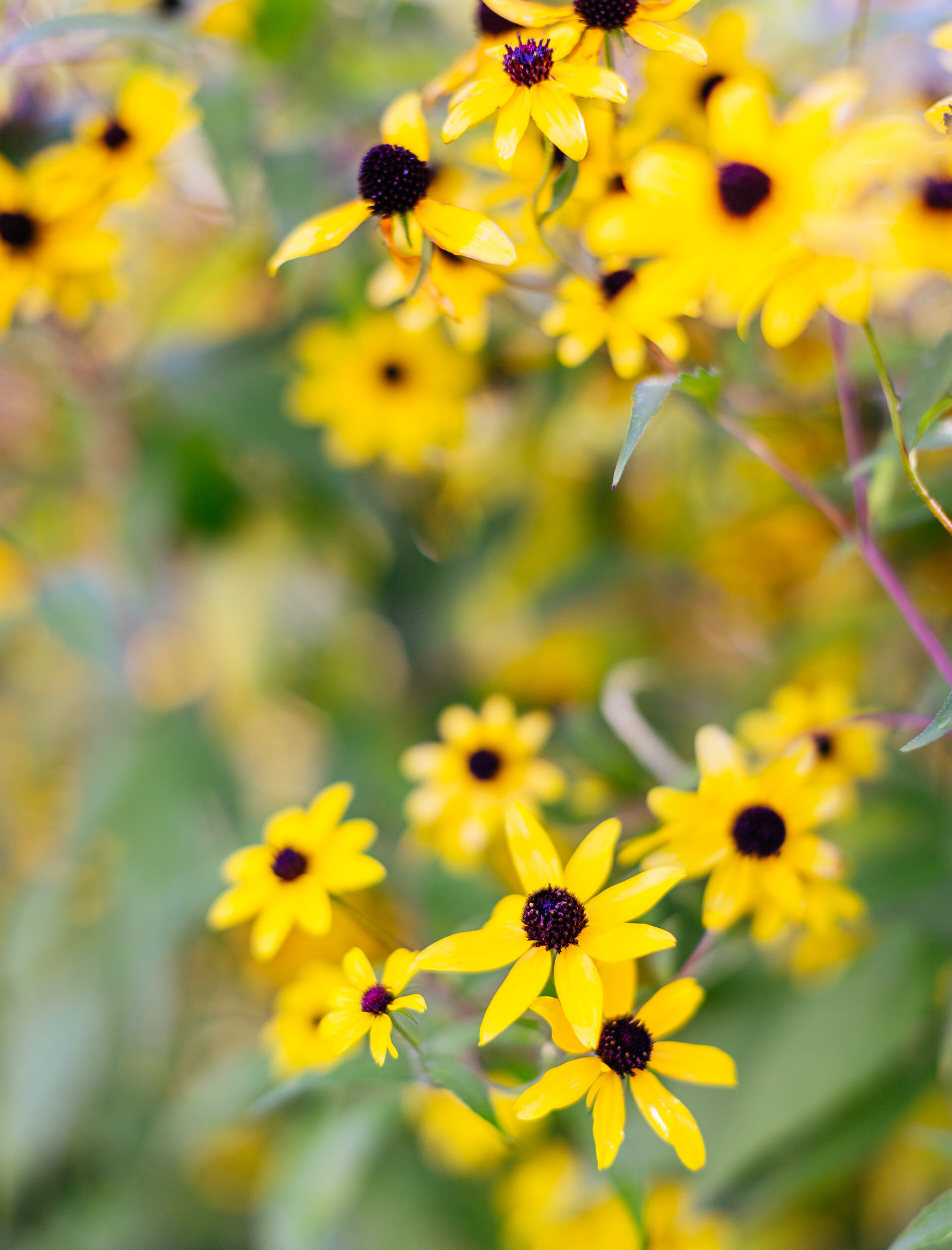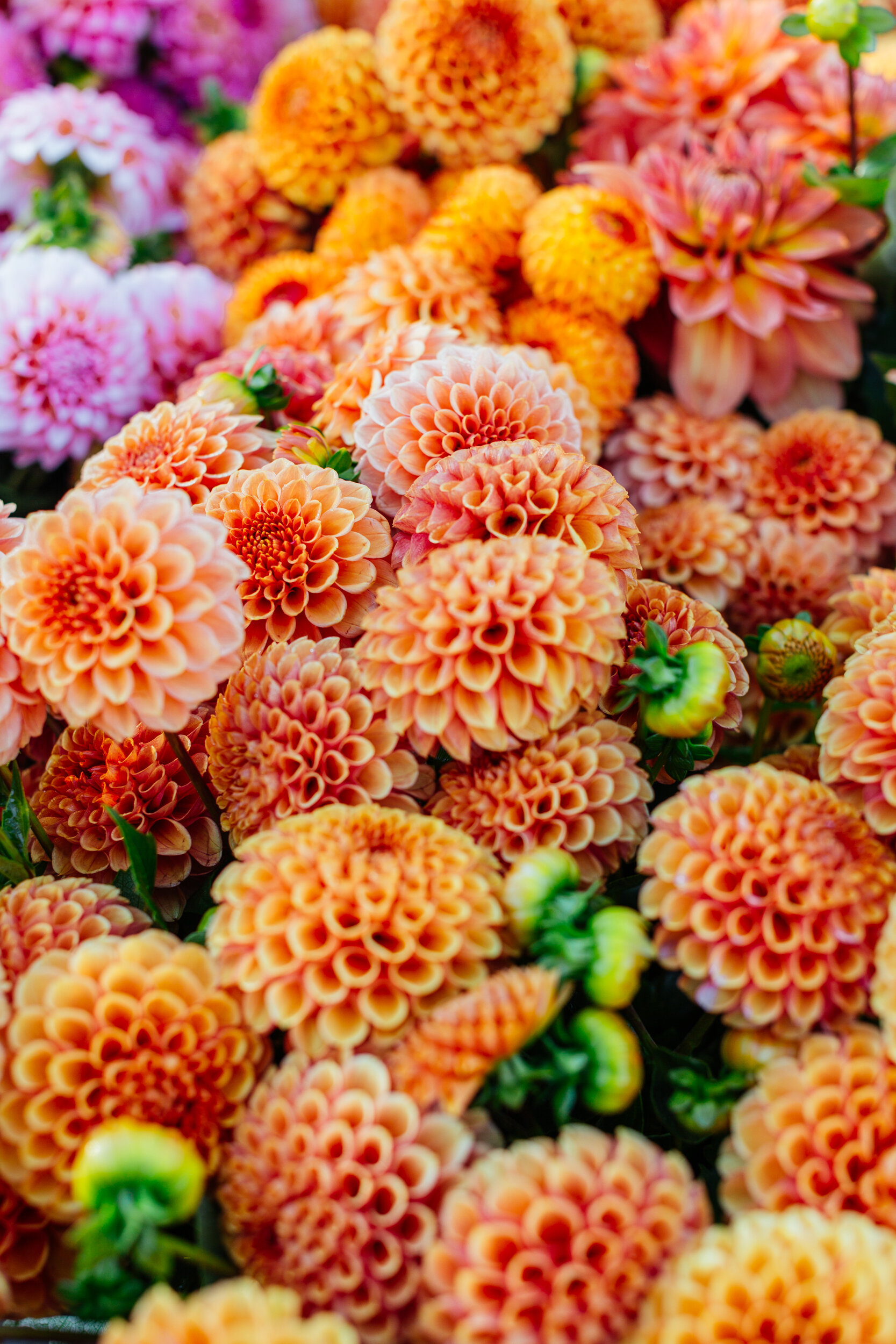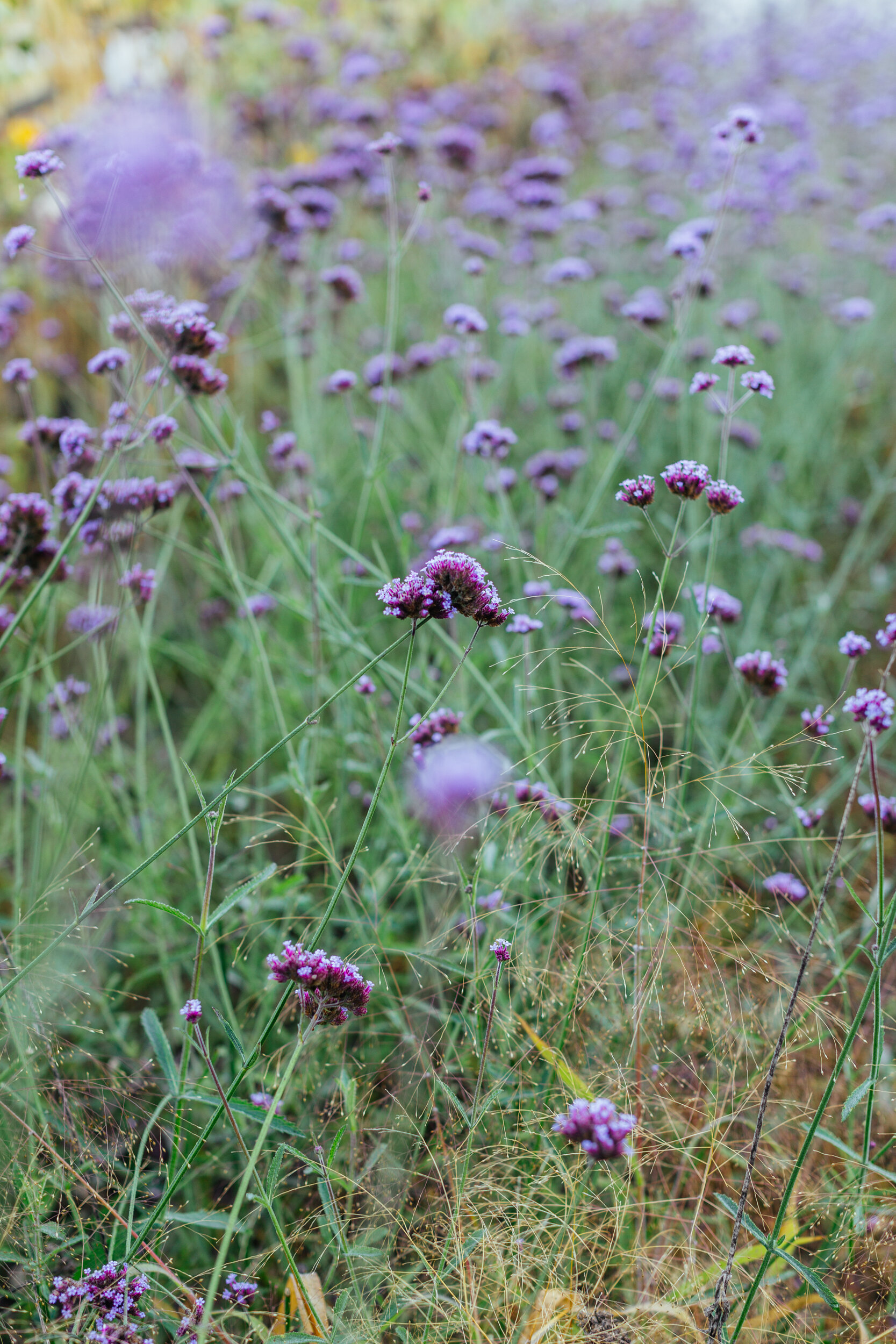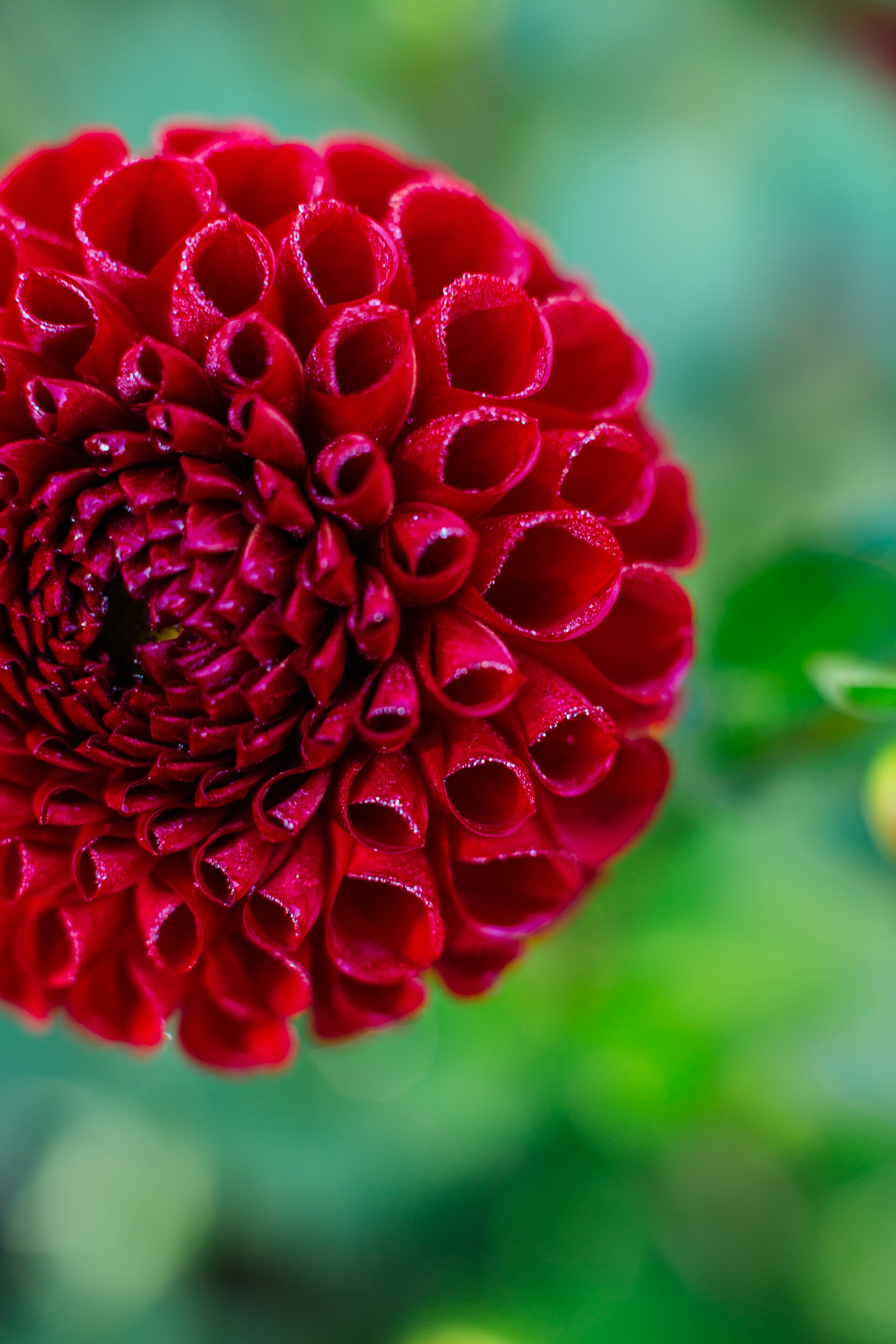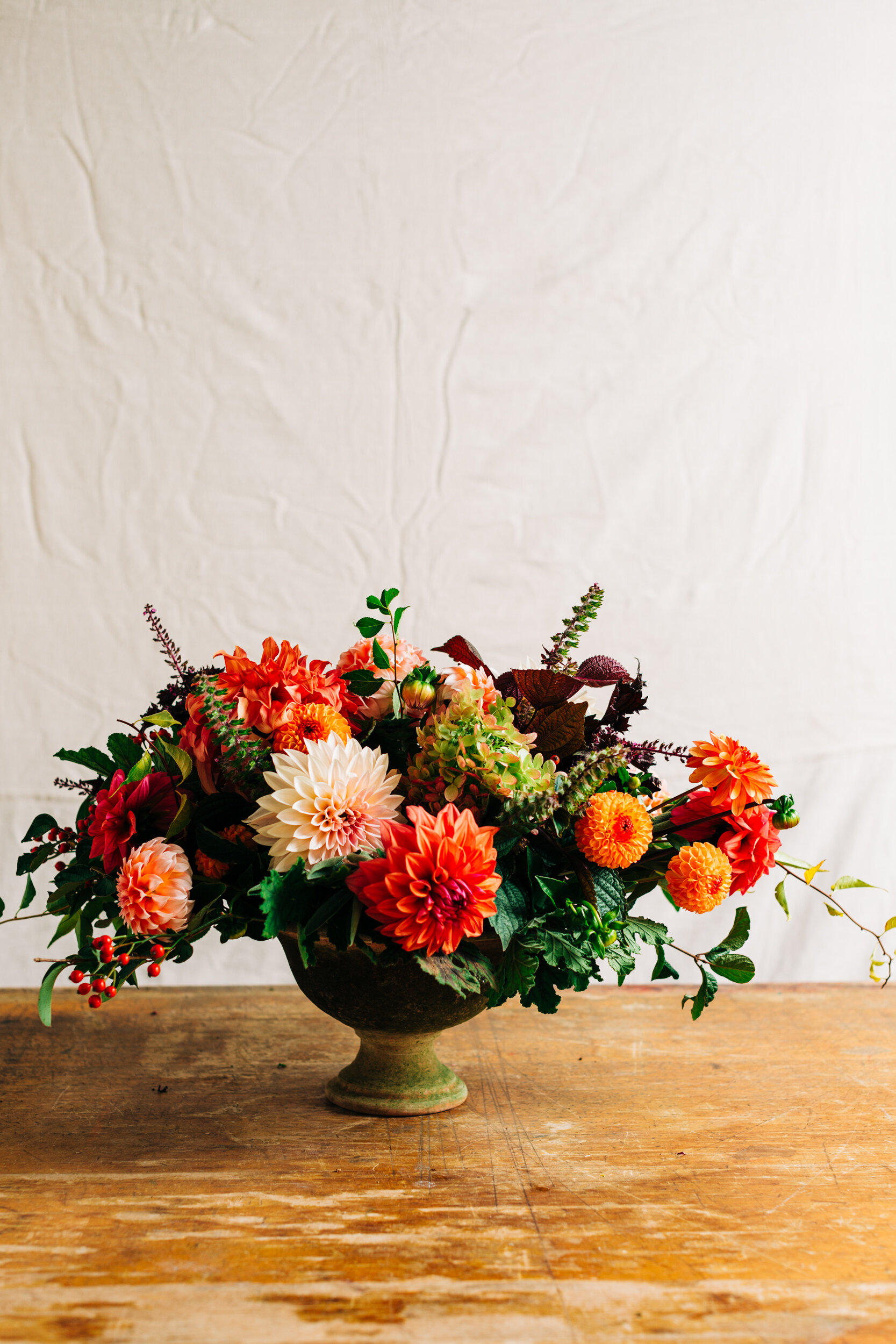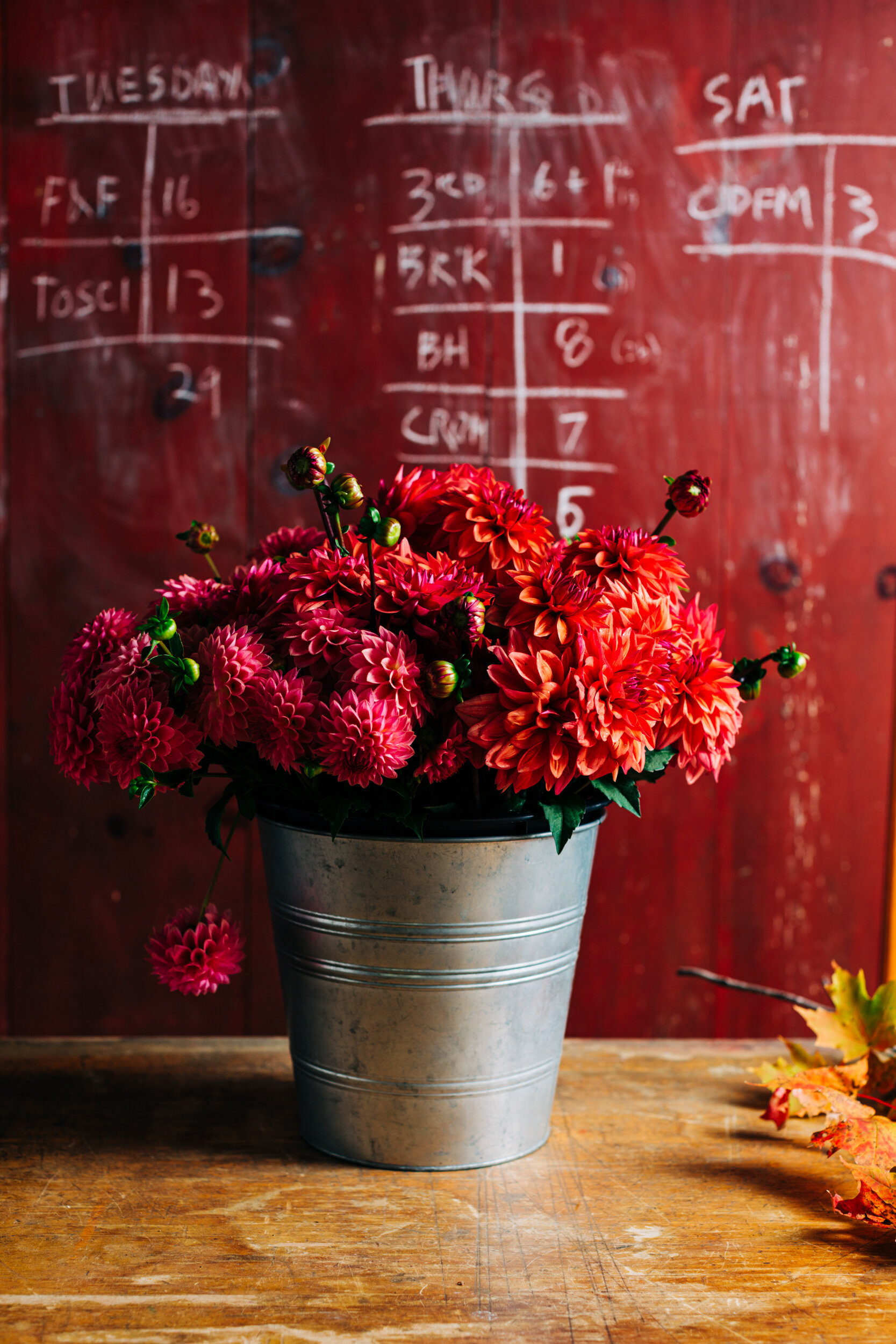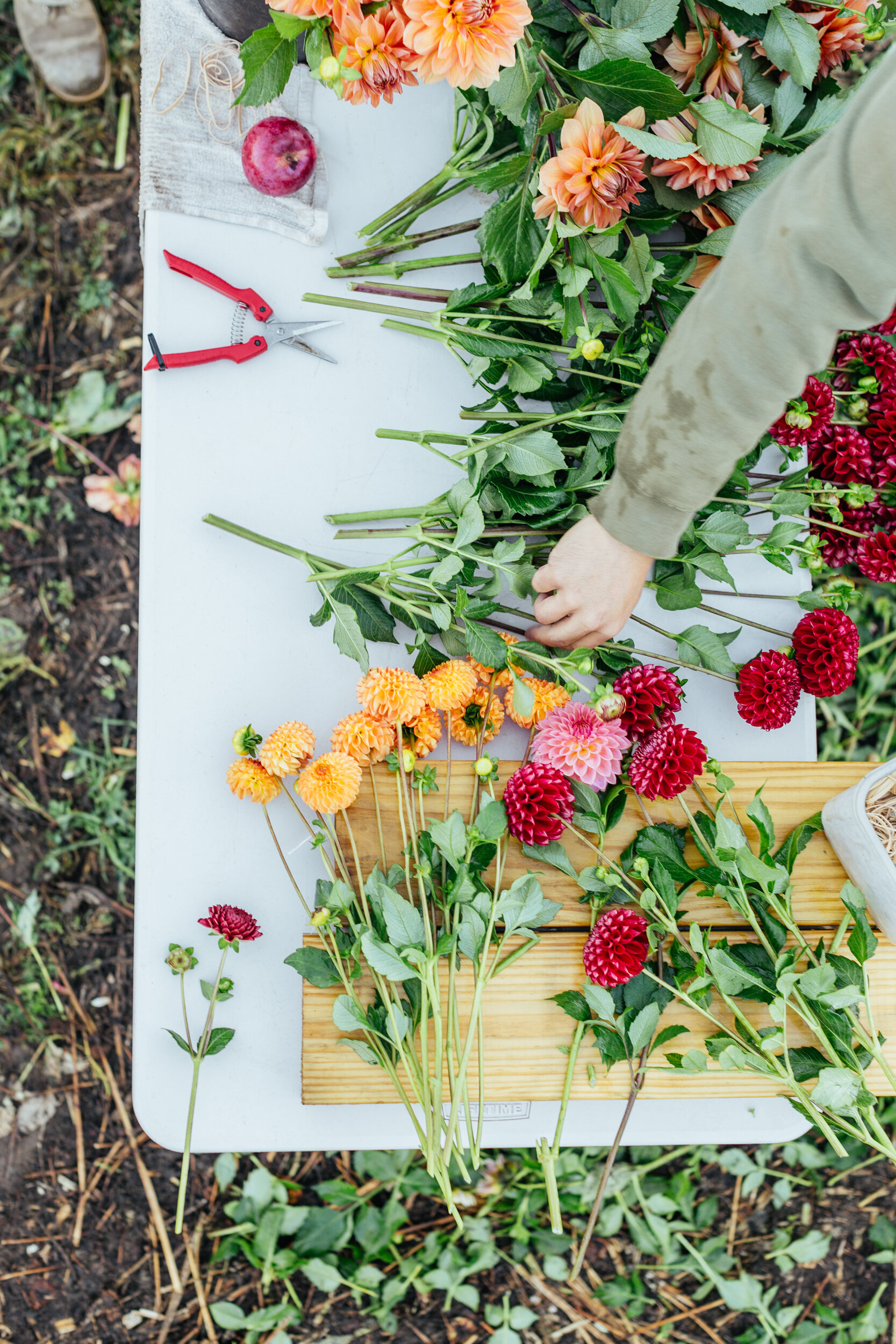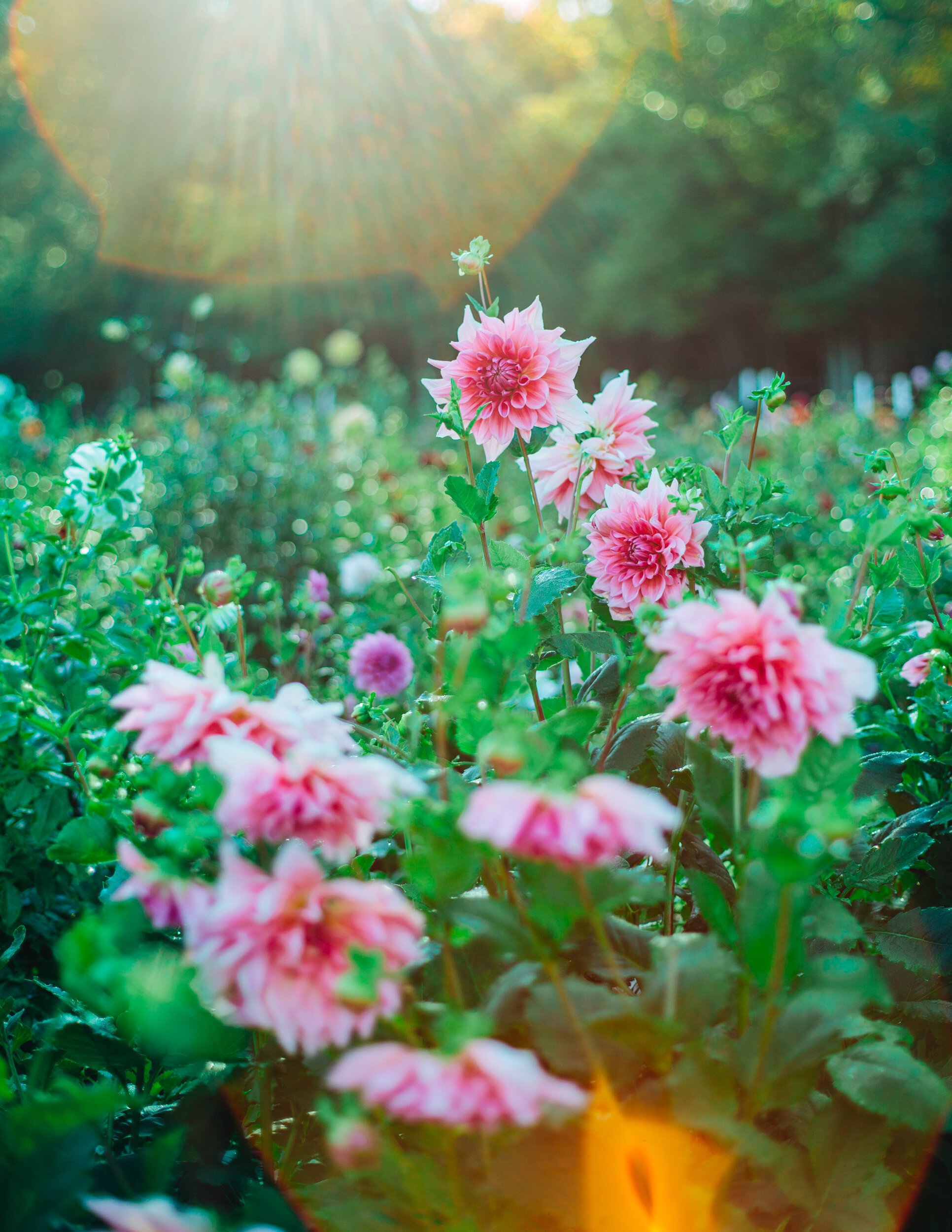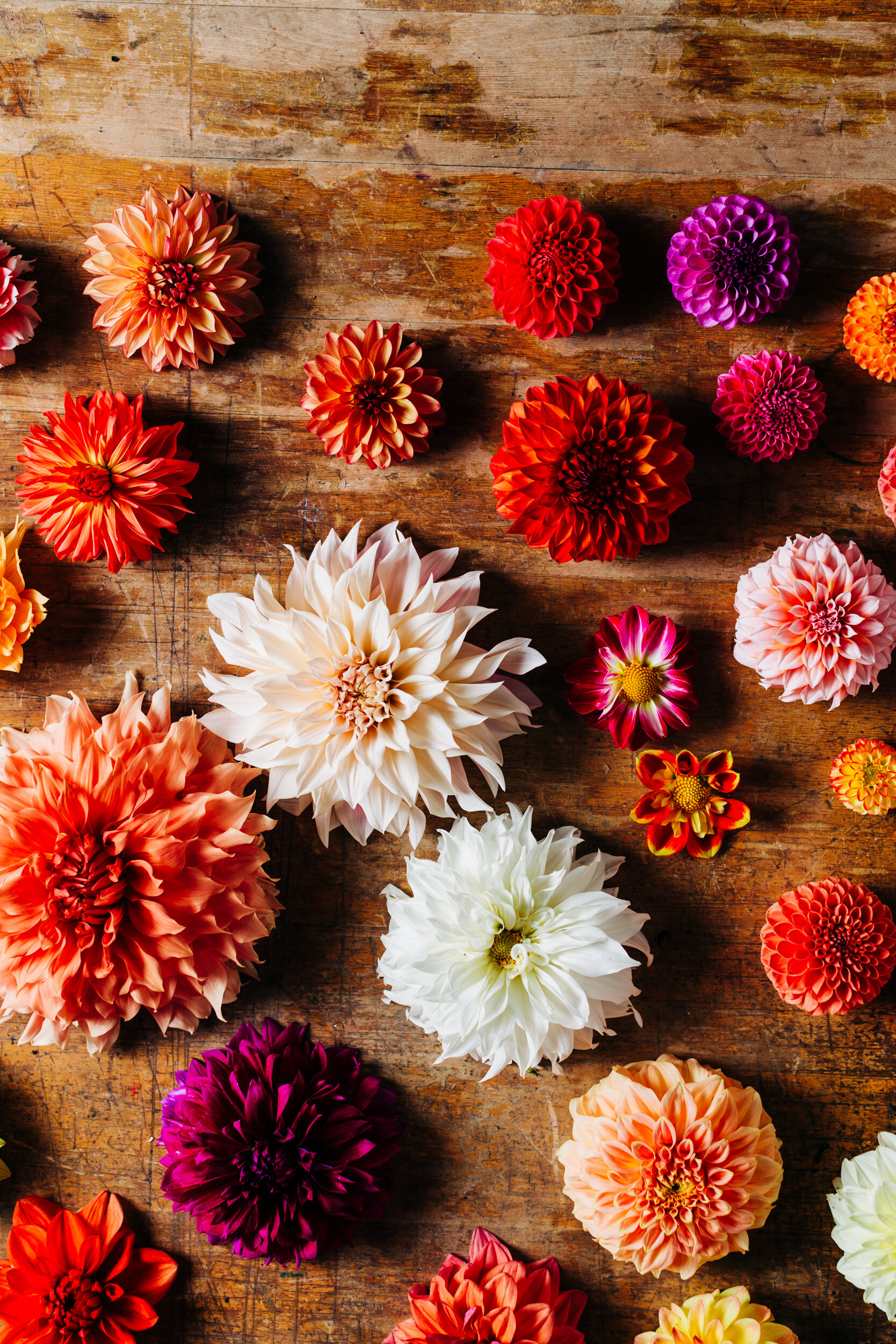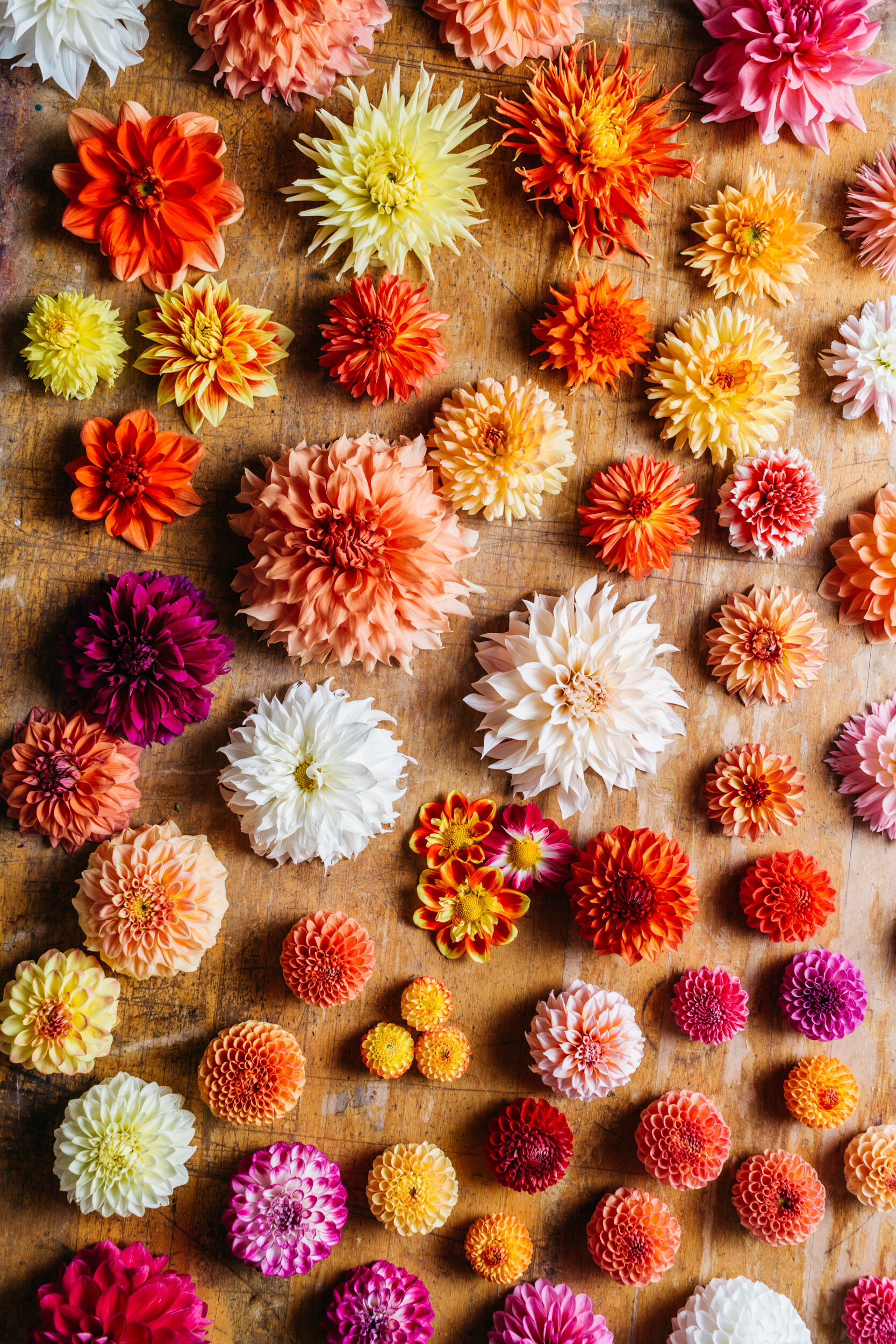Blooming and Booming: For Area Farmers, Raising Cut Flowers is a Beautiful Thing
Photos by Michael Piazza
It’s a rare sunny day in a soggy summer, and the flowers on Emily G. Round’s little plot are showing appreciation. Prairie gentians (Lisianthus) raise pale lavender faces to the sky; tight, white heads of feverfew bob in a breeze; tiny larkspurs look like miniature white orchids. As we walk between rows of flowers planted in black plastic, bees make sorties through the flowers and hoverflies search for aphids. Zinnias bloom in profusion—orange, coral, dark pink and variegated pale greens and blush rose. Delicate blue-gray poppies wave in one row while magenta cockscomb (Celosia) and golden strawflowers sturdily sway. The very first bright coral-hued dahlia is blooming, one of 3,000 planted.
To the owner of Grounded Flower Farm, these flowers are more than beautiful—they are her livelihood.
Round, who farms in the New Entry Sustainable Farming Project in Beverly, is part of a cadre mostly of women who are tilting the floral market local. And customers are finding value in a fragile and perishable product that gives enough joy to warrant paying higher prices than for blooms flown in from other continents.
Growing flowers for sale in the Northeast involves constant calculations about the weather, the scarcity of available land and the need to coax buyers away from imported flowers. Why local, one might ask, since these flowers can cost more than imported bunches? And where does a farmer sell these delicate products when customers have almost everything dropped at their doors?
“Our flowers have soul,” says Nikki Bartley, owner of Cross Street Flower Farm in Norwell, explaining that flowers picked the morning they’re delivered are “so fresh that they still look alive.” For Round, the fact that the blooms last a week or more changes the cost basis. That’s not to mention the scent of the flowers, or the fact that local flowers are usually grown without pesticides. Or that bees depend on them for pollination.
Answering the question of “why” requires a dip into today’s cut flower market. Flowers were once viewed as a luxury, rarely shipped very far and mostly grown domestically. But fuel shortages in the ’70s and cheaper air transport along with U.S. aid partly designed to counter the growing of coca for cocaine led to the rise of flower enterprises in Colombia, Ecuador, Central America and later in Africa, where labor is cheap, pesticide controls are often less stringent and climate is optimal. By the ’80s, most of the flowers sold in the U.S. were imported, and prices dropped. Customers began to casually pick up a bouquet at the grocery, often disregarding the seasons or whether the flowers had a scent. Flowers were no longer seen as a luxury, and the consumer usually had no idea where they came from.
But as the movement toward local food began to grow on the coasts and elsewhere in the 2000s, things shifted. Although 80% of the cut flowers sold in the United States are still imported, according to a July 2021 article inBloomberg News, domestic flower sales rose 9% from 2015 to $4.77 billion in 2018, and the number of those growing flowers also increased slightly, according to the U.S. Department of Agriculture. Social media stars such as Erin Benzakein of Floret Flowers in Washington state, whose blog and TV appearances start trends, showed that selling cut flowers locally could be successful. Local florists and wholesalers began to notice. Rebecca Remis of Birdie’s Blooms, who provides flowers for weddings and events in the Boston area and Western Massachusetts, tries to buy as many local flowers as possible. “Any way to limit the carbon footprint is a good thing,” she says, adding that local flowers have the advantage of being “so delicate, so unique” with beauty and scent that flowers bred for long shipping can’t match.
The community-supported agriculture (CSA) model, where customers pay up front for weekly deliveries during the season, has been a boon to flower farmers. Bartley started flower farming after running a town-supported CSA on the historic Jacobs farm in Norwell. Now on seven acres and with several greenhouses, she has a healthy CSA program for her daffodils, peonies, 8,000 dahlias and 50 different annuals as well as a pick-your-own program, wedding and event clients, weekly specials and a garden shop. Her CSA list is 700 strong; customers are mostly women, ages 30–70. Last December, her CSA shares for 2021 sold out in two weeks.
And although the first days of the pandemic closed florists temporarily, the shutdowns actually helped local flower sales. Tina Bemis, past president of the Massachusetts Flower Growers Association and owner of Bemis Farms Nursery in Spencer, says flower sales are up “tremendously” and that “people are certainly appreciating flowers more.” Last year, Round says, some customers bought several CSA shares, one for themselves and others as gifts for essential workers. Bartley says that customers, who had to come to her farm to pick up CSA flowers, told her it was the high point of their week.
Before COVID, the sunflower may have been a pivotal point for local flowers. “We started growing them in Year 1,” says Chris Kurth of Siena Farms, whose first crops were in the late ’90s. For years, the giant sunflowers—grown, Kurth says, because they’re the flower crop most like vegetables—were a standout at Copley Square Market in Boston. Now, the Siena Farms store in the South End can sell 100 stems a day. And Siena has a special sunflower CSA share with members who pay up to $300 for 10 weeks of blooms.
For some farmers, like Kurth and Chris Grant of Grant Family Farm in West Newbury, flowers are a surprisingly robust part of their overall farm sales. Grant, who farms with his fiancée, Alice Tonry, says that flowers are an instant draw to their roadside stand. A bucket of sunflowers “catches people’s eyes,” he says. Bunches of sunflowers and other flowers—snapdragons, delphiniums, zinnias, verbena, stock and celosia—are also sold at the three farmers markets (Marblehead, Salem and Swampscott) that the farm participates in.
Tonry sometimes can’t keep up with the demand. “Last year people were ferociously buying flowers,” she says, adding that more than once people tracked her down in the field to ask her to cut more. Although eggs and vegetables are the bulk of their farm products, Grant and Tonry are looking to increase flower sales by extending the season.
That’s the name of the game for full-time local flower farmers. New England does not have Colombia’s climate, so growing in the shoulder seasons when customers don’t have flowers in their home gardens is important. One successful three-season grower is Fivefork Farms of Upton. Grace Lam, who farms about eight acres with her brother, Lyh-hsin Lam, and with the help of three other siblings and her parents. She explains that Fivefork is known for tulips, anemones and peonies in the spring and early summer, and then for dahlias in the fall. To do this, the farm has invested in greenhouses and high tunnels—four heated, three unheated and two propagation greenhouses. Selling 60,000 tulips in the spring and having 50,000 dahlia plants for late summer and fall sales keeps six full-time workers and three part-timers busy. In fact, this summer Lam closed her farm stand for July and August. “By the time it gets through to June, it’s time to take a break,” she says, adding that her staff needs time to prepare for winter work.
Besides the farm stand, Lam’s flowers go to wholesale customers and CSA customers. Pickups for Boston-area CSA customers are at small businesses, such as Tatte bakeries and ice cream shops. Although previously Fivefork participated in Boston-area farmers markets, the labor involved and uncertainty of sales led Lam to cancel for this year.
All of this is hard work, and the hours are brutal. “All flowers, like greens, must be harvested before the sun comes up,” says Lam, “or after 6pm.” In fact, Barbara Rietscha, who ran Stow Greenhouse’s Field & Vase for many years (and is now Edible Boston’s operations manager), found that, though her sales were good, the pressure from the cheaper imported supply made it challenging which is why local flower farmers grow specialty varieties that are hard to import. “In the end,” she says, “I decided to retire from flower farming when my passion waned because you definitely need to be all in."
Divining what customers want is another part of the puzzle. Lam says it’s tricky—buyers want certain colors, certain shapes, certain types of flowers—and tastes constantly change. Social media, especially Instagram, is crucial for many flower farms and other ways of marketing are also helpful, such as the garden kits Cross Street Flower Farm put out last year when customers couldn’t shop in the store or come to workshops. Growers also offer extras from classes to specials to pop-ups to appeal to customers.
After hard work and marketing, the question remains: Is growing and selling flowers a viable business? To Bartley, who like Lam of Fivefork Farms has a finance background, says: “Farming is hard. But if you’re smart and you know your margins, you can make it work.” Cross Street Flower Farm has had “massive growth in the past five years,” she says, and now she’s trying to streamline. Her staff is almost all women and she agrees that local flower farming is predominantly female. “Men never saw flowers as profitable,” she opines. But she and her team were taught to drive tractors by older men who “cheered me on.”
Lam and her family believe in the necessity of making “profit-driven” decisions. “Man, there are days when I wished I didn’t have to get out” in the field, she admits. There’s “not a huge profit,” Lam says, but the business is “supporting the employees.”
That, and as Round can attest as she surveys her flowers on a summer’s day, the flowers provide beauty for customers and pollen for the busy bees. As Grant says: “They make people so happy.”
groundedflowerfarm.com
crossstreetflowerfarm.com
bemisfarmsnursery.com
birdiesblooms.com
sienafarms.com
grant-family-farm.com
fiveforkfarms.com
This story appeared in the Fall 2021 issue.

